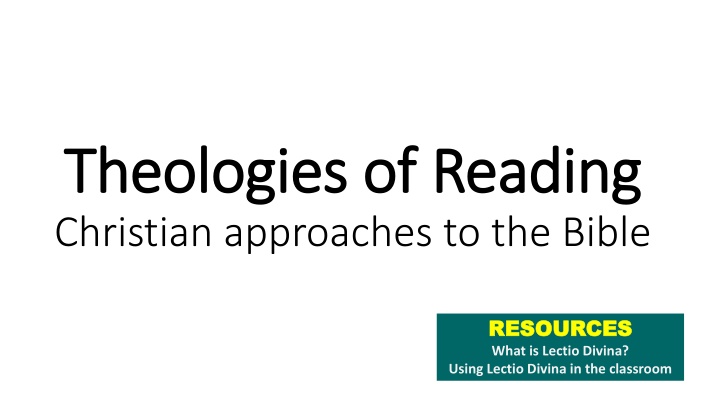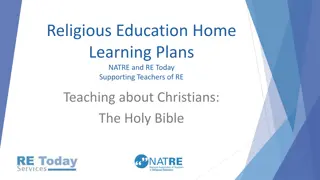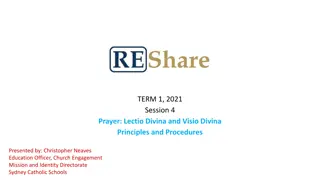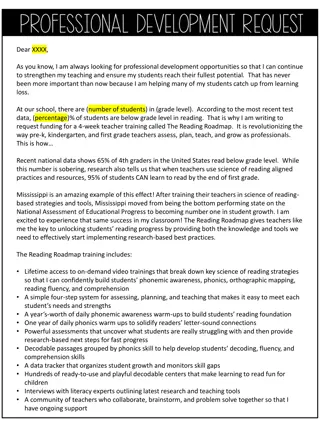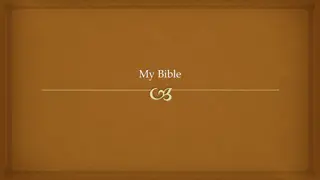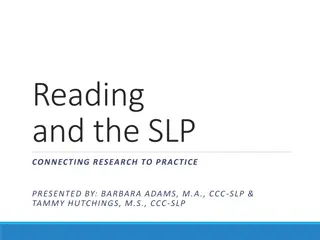Christian Approaches to the Bible - Lectio Divina & Ambient Reading
Explore the ancient practice of Lectio Divina, a contemplative way of reading the Bible that deepens your connection with God's Word. Delve into Ambient Reading theory, focusing on how surroundings impact our interaction with texts. Enhance your understanding and application of Practical Criticism for reflective reading.
Download Presentation

Please find below an Image/Link to download the presentation.
The content on the website is provided AS IS for your information and personal use only. It may not be sold, licensed, or shared on other websites without obtaining consent from the author.If you encounter any issues during the download, it is possible that the publisher has removed the file from their server.
You are allowed to download the files provided on this website for personal or commercial use, subject to the condition that they are used lawfully. All files are the property of their respective owners.
The content on the website is provided AS IS for your information and personal use only. It may not be sold, licensed, or shared on other websites without obtaining consent from the author.
E N D
Presentation Transcript
Theologies of Reading Theologies of Reading Christian approaches to the Bible RESOURCES RESOURCES What is Lectio Divina? Using Lectio Divina in the classroom
Lectio Divina (divine reading) Lectio Divina is a contemplative way of reading the Bible. It dates back to the early centuries of the Christian Church and was established as a monastic practice by Benedict in the 6th century. It is a way of praying the scriptures that leads us deeper into God s word. We slow down. We read a short passage more than once. We chew it over slowly and carefully. We savour it. Scripture begins to speak to us in a new way. It speaks to us personally, and aids that union we have with God through Christ who is himself the Living Word. Extract from What is Lectio Divina? information sheet
Working with Lectio Divina Rev Lindsay Yates, Chaplin at Westcott House, Cambridge, uses Lectio Divina in a group setting. She stresses the following before attempting group lectio: It is an ancient method of Praying with Scripture. It is based on the belief that Christ is truly present in Scripture and that the reading of Scripture allows God to speak It is a receptive way of praying. Biblical interpretation can be useful but engaging in lectio is not concerned primarily with ascertaining theological or doctrinal truths but listening to what God is saying through the text. It is not a discussion and no one comments on what another person shares. Group lectio involves an invitation to share but sharing is not compulsory. Groups listen to what is shared in the belief that God communicates with through other members of the group The quote on the previous slide is from a longer document; What is Lectio Divina? Read more to find out Try Lectio Divina in the classroom guidance sheet
Ambient Reading This is a theory that focuses on the importance of the surroundings and context with which we read and how reading in different circumstances can really affect the way we interact with the text as readers. Readers are viewed as makers . IN THE CLASSROOM: Give pupils sections of sacred text and ask them to read it in different locations e.g. in the classroom, in the library with other books, outside, at home in their bedroom. Invite them to record how the text changes for them when read in different locations. Do different things seem more important or take on new meaning when the context for reading changes?
6 main assumptions of Practical Criticism: Don t be too concerned about authorship History, context, etc come after the free personal judgement Poetic language is not like ordinary language Multiple valid responses are expected Text offers a verbal analogue to experience and does not simply refer to experience Reading necessarily involves appreciation Practical Criticism Practical Criticism encourages reflective and close reading of individual texts, a kind of reading which dwells upon the artistry of particular passages and that artistry s implications, or which examines those works arguments and rhetoric Where practical criticism is understood tomean the exercise of close attention to writing, informed by historical understanding and imaginative response, the conclusions of which are then organised rationally in the service of a coherent argument. Inevitably, close reading of this sort invites students to articulate their own individual responses to texts, but these interpretations must then be presented under the light of reasoned and shareable day- i.e. by weighing up evidence and arguing the case for one s particular judgements L. M. Kilbride, University of Cambridge
Practical Criticism Allow pupils to approach a sacred text in a non-threatening way 1) Read through the text in your head or under your breath for and make note of any difficulties, moments of tensions, lines/words/phrases which really appeal or don t appeal at all. 2) Write a few lines about it. Any favourite lines? Any parts you feel require further thinking? Any aspects of form which seem particularly striking, important or worth mentioning? 3) Share responses with the group. 4) Fill in - providing historical information, important subject knowledge related to the text (substantive knowledge) or how it was formed (disciplinary knowledge) 5) Work in pairs: any further thoughts/comments based on what you now know?
Infographics Infographic bibles are a great resource www.theinfographicbible.com/ www.harpercollins.co.uk/978031 0520436/visual-theology Choose a popular or well-known Biblical passage, book or story. Compare to its presentation in an infographic bible. What essential information is retained/lost? Does it matter? Can pupils create their own infographics based on given text? Can they match infographics to different passages of text?
Read and Respond Providing a piece of text and asking pupils to read and then respond in some way could provide some interesting interpretations For example, providing each group with one of The Beatitudes and then asking them to represent it through drama or tableaux would produce varied representation. Equally, providing text and asking pupils to produce art or music in response could yield diverse and creative understandings of text.
Book of Hours A Book of Hours is a book of prayers appointed for particular canonical hours or times of day, used by Roman Catholics for private devotions and popular especially in the Middle Ages, when they were often richly illuminated. Search on the internet for images of Books of Hours from Medieval Europe. Get creative Invite pupils to create their own Book of Hours , selecting texts that mean something to them personally or texts along a given theme across traditions e.g. peace. They could illuminate letters and add their own annotation. Presenting texts in the centre of paper with plenty of room around it for annotation or silent debate is in keeping with this tradition of personal devotion. These are interesting when looking at devotional practices linked to texts as artefacts and how ownership is shown through annotation.
Former assistant head teacher at a large primary school in Nuneaton. Former English subject leader (13 years) and Lead Teacher for Royal Shakespeare Company (2 years), as well as RE subject leader for 15 years. Currently working one day a week as RE Facilitator for Coventry and Warwickshire on behalf of both SACREs working jointly and some work for Coventry Diocesan Board of Education. ICON School Project Manager for Coventry Cathedral. ICONS are schools awarded a Cross of Nails (a symbol of peace and reconciliation following the Coventry Blitz in November 1940) for their commitment to teaching children and young people how to be peace-makers and reconcilers. Lover of all things literary and text-based and super fan of lifelong learning. Jennifer Jenkins RE Facilitator for Coventry and Warwick
